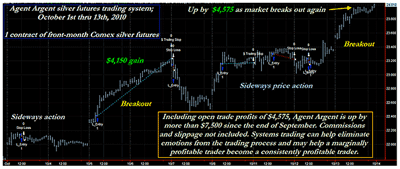Being a market technician doesn't necessarily make a person the world's greatest trader, although most skilled technicians actually do a good job of accurately describing the technical probabilities surrounding any given trade set-up. Trading systems, on the other hand, use a robotic, digital "yes-no" kind of logic to trigger trade entries, totally committed to the trade until final stop-out at a loss or gain. They have no reputation to protect, nor are they biased for or against any given trade set-up. Here's a brief look at my recent call for an interim top in silver, followed by a look at what actually happened—and why using a professional-quality trading system might have been a preferred way to trade the silver market, regardless of the chart patterns that may have suggested that a top was imminent.
Over, under, sideways, or down—no matter the market phase—a well-designed trading system should be able to capitalize on various kinds of market conditions. This particular system attempts to milk substantial profits from one- to four-day trend moves in the silver futures market.
The great thing about using a trading system is that when a losing trade occurs, you never take the loss personally. Afterall, it was the system that made the trade, right? Of course, you need to be using a well-tested, proven system before actually having the guts to trade with it in the first place, but if your system is a consistent performer, then the streaks of wins and losses don't take as heavy a toll on your emotions compared to the stress caused when a purely discretionary trading method suddenly goes bad.
A few days ago, I suggested that the silver market was in a prime position to stage a trend reversal, especially if a particular Keltner channel midline and cycle low were taken out. Okay, so I hedged my call to go short by stating that the short set-up was a go only if certain support levels were breached. If those levels ($22.35 being the critical support level) were obliterated, then this would have been a very logical short set-up confirmation.
Meanwhile, my Agent Argent silver futures trading system wasn't about to get involved in any speculation about probable market direction. No way. In fact, since it's a purely mechanical system, it knew exactly what market conditions would trigger a long or short trade, and how many contracts to trade once a signal was given.
Well, Agent Argent went long on Tuesday, October 12, at $23.185, and as of Wednesday's close, the trade had an open profit of $4,575 per contract of full-sized COMEX silver (Figure 1). Not bad for a day's work, but the trade hasn't stopped out yet, so there's no need to count any chickens before they're hatched. However, the trailing stop employed by the system virtually guarantees at least a $2,800 closed profit, barring some sort of limit down price action (relatively rare).
Again, this system has a winning percentage in the high 30% range, so don't expect every trade to produce such large dollar gains. But it is fairly consistent in its ability to latch onto every significant swing move in the silver futures market. Even better, using this system (or any other proven trading system) helps eliminate all of the second guessing and the "Will it or won't it" kind of reasoning that drives discretionary traders up a wall as they weigh all the various pros and cons of the trade setups that they encounter.
If you've been struggling to turn a profit by way of market newsletters and advisory services or discretionary trading methods, then why not consider the benefits that may be afforded by employing a strictly mechanical (and fully stress-tested) trading system instead? Take your time, ask plenty of questions, and investigate your options within the world of mechanical trading strategies, and over time, you should be able to hone in on the very best systems for your particular trading needs and goals. If you have substantial trading account funds, consider diversifying your funds across three or even four different quality systems to help smooth out your overall equity curve.
By Don Pendergast of ChartW59.com






















